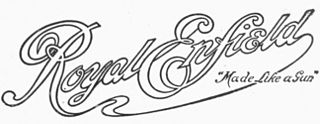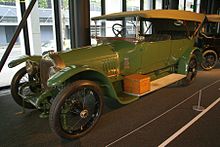
The Standard Motor Company Limited was a motor vehicle manufacturer, founded in Coventry, England, in 1903 by Reginald Walter Maudslay. For many years, it manufactured Ferguson TE20 tractors powered by its Vanguard engine. All Standard's tractor assets were sold to Massey Ferguson in 1959. Standard purchased Triumph in 1945 and in 1959 officially changed its name to Standard-Triumph International and began to put the Triumph brand name on all its products. A new subsidiary took the name The Standard Motor Company Limited and took over the manufacture of the group's products.

L'Aster, Aster, Ateliers de Construction Mecanique l'Aster, was a French manufacturer of automobiles and the leading supplier of engines to other manufacturers from the late 1890s until circa 1910/12. Although primarily known as an engine mass manufacturer the company also produced chassis for coach-works and a complete range of components.

Royal Enfield was a brand name under which The Enfield Cycle Company Limited of Redditch, Worcestershire sold motorcycles, bicycles, lawnmowers and stationary engines which they had manufactured. Enfield Cycle Company also used the brand name "Enfield" without the "Royal".

Sunbeam Motor Car Company Limited was a British automobile manufacturer in operation between 1905 and 1934. Its works were at Moorfields in Blakenhall, a suburb of Wolverhampton in Staffordshire, now West Midlands. The Sunbeam name had originally been registered by John Marston in 1888 for his bicycle manufacturing business. Sunbeam motor car manufacture began in 1901. The motor business was sold to a newly incorporated Sunbeam Motor Car Company Limited in 1905 to separate it from Marston's pedal bicycle business; Sunbeam motorcycles were not made until 1912.

Singer Motors Limited was a British motor vehicle manufacturing business, originally a bicycle manufacturer founded as Singer & Co by George Singer, in 1874 in Coventry, England. Singer & Co's bicycle manufacture continued. From 1901 George Singer's Singer Motor Co made cars and commercial vehicles.
The Lanchester Motor Company Limited was a car manufacturer located until early 1931 at Armourer Mills, Montgomery Street, Sparkbrook, Birmingham, and afterwards at Sandy Lane, Coventry England. The marque has been unused since the last Lanchester was produced in 1955. The Lanchester Motor Company Limited is still registered as an active company and accounts are filed each year, although as of 2014 it is marked as "non-trading".

Morris Oxford is a series of motor car models produced by Morris of the United Kingdom, from the 1913 bullnose Oxford to the Farina Oxfords V and VI.
The Calthorpe Motor Company based in Bordesley Green, Birmingham, England made a range of cars, motorcycles and bicycles from 1904 to 1932.

The Ner-A-Car was a type of feet forwards motorcycle designed by Carl Neracher in 1918. It used an unusual steel-channel chassis, much like an automobile, and hub-center steering at the front wheel, making it 'nearly a car' in design. The Ner-A-Car was the most successful hub-center steering motorcycle ever produced, with sales far eclipsing earlier or later examples of this design, such as the Yamaha GTS1000 or Bimota Tesi. About 10,000 Neracars were manufactured in the United States by the Ner-A-Car Corporation, while around 6,500 are believed to have been produced in England under licence by the Sheffield-Simplex company between 1921 and 1926 under the Ner-A-Car name.
Rex, Rex Motorcycles, Rex-Acme, was a car and motorcycle company which began in Birmingham, England in 1900. Rex soon merged with a Coventry maker of bicycles and cars named Allard and then later in 1922 the company merged with Coventry's 'Acme' motorcycle company forming 'Rex Acme'. The company existed until 1933, and, in its heyday, was considered one of the greatest names in the British motorcycle industry.

The Austin 10 hp is a high-quality small car produced between 1910 and 1915 by the British car manufacturer Austin Motor Company Limited at their Longbridge, Worcestershire plant near Birmingham. 1,336 cars were made, 213 with the 1125 cc engine and 1,123 with the 1615 cc engine. Like the 1087 cc Austin 7 hp produced by both Austin and Du Cros's Swift Motor Company it was not very successful when sold with the small engine.
Blackburne was a trade name of Burney and Blackburne Limited a British manufacturer of motorcycles from 1913 to 1922 at Tongham near Farnham, Surrey. They were also a major supplier of engines to other motor cycle and light car makers and continued to make these until 1937. Burney and Blackburne also made small aircraft engines.

The Austin Light Twelve-Six is a 14 tax horsepower car with a 1496 cc engine that was introduced by Austin in January 1931. It was named by Austin Light Twelve to separate it from the well-established Austin Twelve. The general public then dubbed the original Twelve Heavy Twelve but Austin never used that name. The Light Twelve-Six remained in production until 1936.

The Rover 12 was a name given to several medium-sized family cars from the British Rover car company between 1905 and 1948.
The Advance Motor Manufacturing Company was a British motorcycle and engine manufacturer established in 1905. As well as supplying aircraft engines to the pioneering monoplane developers, Advance engines were also used by Captain Robert Scott to power Antarctic snow sleds. After the end of the Second World War the company was sold to Sheepbridge Engineering and became a motor supplies organisation.

Bradbury Motor Cycles was a British motorcycle manufacturer based in Oldham, England and established in 1902. Originally involved in the manufacture of machine tools, sewing machines and cycles, their first motorcycles were bicycles with clip-on Minerva engines. The Bradbury factory went on to develop and produce a range of single-cylinder motorcycle, V-twins and horizontally opposed twins. The 1912 Bradbury motorcycles were one of the earliest with variable gearing. Although the factory survived the First World War it closed in 1924.

The Austin 40 hp is a 4-cylinder motor car launched at the Olympia Motor Show in November 1907. Manufactured by Austin at Longbridge, Northfield, Birmingham, it was the first variant from Austin's initial plans for a two model range of a 15 hp —which they had dropped—and a 25 hp car.

The Warren-Lambert Engineering Co. Ltd. was a British automobile manufacturer that was established from 1912 to 1922 in Richmond, then in Surrey. A. Warren Lambert, was an agent for Morgan cars in Putney which he also raced. In 1912 he designed and started to manufacture a two-seat four-wheel cyclecar from premises in Uxbridge Road, Shepherd's Bush. It was well received and around 25 cars a week were being made.

The "bullnose" Morris Oxford is a series of motor car models produced by Morris of the United Kingdom, from 1913 to 1926. It was named by W R Morris after the city in which he grew up and which his cars were to industrialise.

Peter Brotherhood (1838–1902) was a British engineer. He invented the Brotherhood engine used for torpedoes as well as many other engineering products.

















